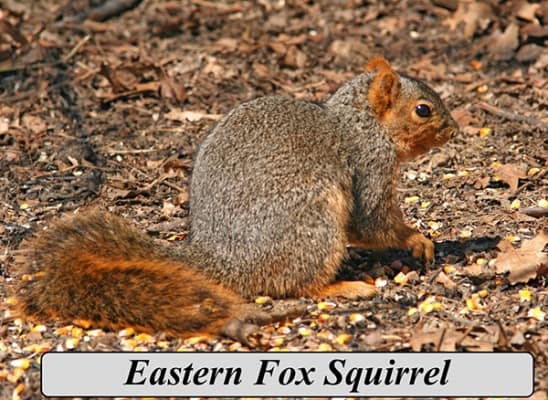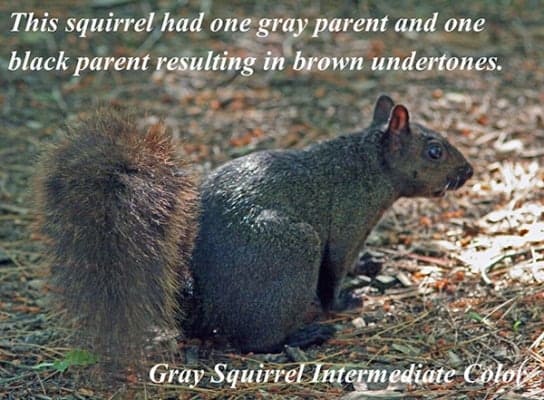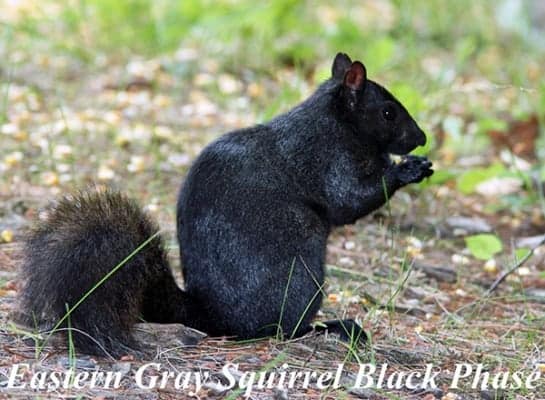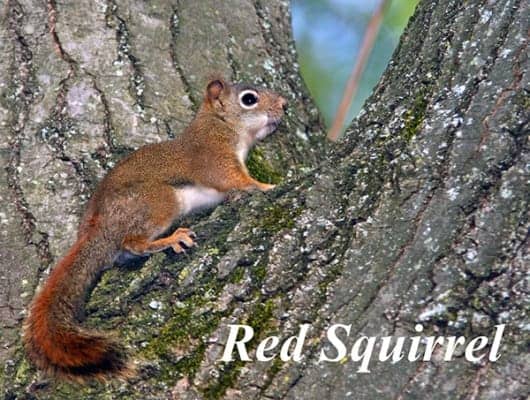
 Story and photos by Tom Hodgson
Story and photos by Tom Hodgson
The days are getting shorter and the weather is cooling down, triggering hoarding instincts in our local squirrels.
There are seven members of the squirrel family in our area. Five store food for the winter and two do not.
You could also separate squirrels into climbers and non-climbers. Climbers come equipped with long, bushy tails and are totally comfortable high above the ground. Non climbers have short thin tails and rudimentary climbing skills at best. We have four climbers and three non-climbers in our area.
The largest of the climbers is the Eastern fox squirrel. We have all heard the story about the country mouse and city mouse. Perhaps the fox squirrel could be called the city squirrel because it is quite comfortable in urban environments. It does not mind traveling on the ground to get from tree to tree. In fact, the fox squirrel is a prairie edge species that does not like dense forests and was rare in Michigan before settlers cleared the land. The fox squirrel’s back is grizzled brown and black. Its face, ears, feet and undersides are a dull orange.
 Eastern gray squirrel
Eastern gray squirrel
The Eastern gray squirrel is slightly smaller than the fox squirrel. It is mostly gray with creamy white undersides. Its favorite habitat is found in extensive tracts of mature forests where it can go from tree to tree without having to come to the ground. It prefers large trees that have hollows for nesting and protection from winter weather. This was Michigan’s most common tree squirrel before the arrival of the European settlers. Cutting of the forests eliminated its preferred habitat and for a while it largely disappeared from our area. Today, it can still be found in urban areas, but it is much lesson common than the fox squirrel.
The gray squirrel is not always gray. Sometimes it is black or a mixture of black and brown. The black squirrels we see up north are a melanistic phase of the gray squirrel. For those of us who do not remember what we learned in Genetics 101, genes for all traits come in pairs. The black color is caused by a recessive gene. The normal gray color is caused by a dominant gene. A black phase gray squirrel is always the offspring of two black phase squirrels. When a gray phase and black phase squirrel mates, the gray gene should dominate and hide the black genes. Ah but wait. There are exceptions. The normal gray color of the gray squirrel is only partially dominant, so when a gray phase and black phase mate, their offspring are an intermediate color of black mixed with brown. Life is never simple.
I have included images of all three phases in the photo array.
There are certain hot spots for gray and black squirrels in Southern Lower Michigan. Battle Creek has been known for them for many years. Why is that? A Nov. 12, 1915 edition of the Battle Creek Enquirer stated, “one hundred gray squirrels have been brought to Battle Creek from the north during the summer and set free under the direction of Dr. J.H. Kellogg. Another shipment is expected soon, and it is probable that by winter over 300 of the animals will have been released here.” It seems that pesky red squirrels were damaging wooden structures, so gray squirrels were brought in to drive them out.
M.S.U. alumni may also remember the large number of black squirrels on campus. W.K. Kellogg deeded his experimental farm, located north of Battle Creek in Ross Township, to the Michigan State College of Agriculture in 1928.
Wilber “Joe” Johnson, chief wildlife biologist at MSU’s Kellogg Biological Station, reportedly trapped black squirrels at the complex in 1958 and 1962 and released them onto MSU’s main campus at the request of its then-president John Hannah, who thought the species to be unique. So now you know.
Fox and gray squirrels are scatter hoarders, burying nuts and acorns singly in many locations throughout their territories. It was once thought that they located these buried treasures by using their keen sense of smell. More recent studies demonstrate that they remember where they buried them. Their memories must be good because they retrieve more than 90 percent. The rest are left behind to grow into trees. They prefer hickory and black walnuts over acorns due to their higher nutritional value.
Red squirrel
The red squirrel is a noisy, scrappy little cuss. It prefers the pine forests of the north, but is adaptable, and does quite nicely among the broad-leaf trees in Washtenaw County. It is much smaller than gray and fox squirrels. Its head, back and tail are a rusty reddish brown. A white ring circles each eye, and a black stripe separates its reddish upper parts from its white belly. The red squirrel is a cache hoarder storing its winter food supply in tree hollows, or in burrows dug for that purpose. Sometimes they just pile the stash next to a convenient tree stump.
 Southern flying squirrel
Southern flying squirrel
Other than the least chipmunk of the U.P., the Southern Flying Squirrel is the smallest member of the Michigan squirrel family. It measures about 10 inches from nose to tail. Its oversized eyes make this squirrel look like a caricature from a Margaret Keane painting. All the better to see in the dark as it is primarily nocturnal.
Is it rare? No, it is just as common and as busy as our daytime squirrels, but all its activities are hidden by darkness. It is probably visiting our bird feeders at night without our knowledge. It does not fly as its name implies. Its tail is flattened, and a large fold of skin stretches from ankle to wrist that allows it to glide through the air, often for 30 feet or more. It makes extensive use of tree cavities for caching food and for nesting. I have found flying squirrels in bluebird nest boxes.
Eastern chipmunk
The Eastern chipmunk is most common where there is a mixture of trees, shrubs and open areas. It creates elaborate underground burrows. It can climb but spends most of its time on or under the ground. There is no mound of soil at the entrance of a chipmunk burrow because it carries all the excavated soil away and deposits it elsewhere. The chipmunk is a cache hoarder, placing its winter food supply in storage rooms in its burrow. In winter, it spends most of the time sleeping in its burrow, waking periodically to eat. It may be seen above ground during a major thaw.
Thirteen-lined ground squirrel
The thirteen-lined ground squirrel is a grassland animal that is a little larger than a chipmunk. It likes grass short enough to see over, so golf courses and large mowed areas are ideal. It is a true hibernator and does not hoard food. It begins hibernation in October and will not be seen above ground until May. During hibernation, its heartbeat slows from 200 to 20 times per minute and its body temperature falls to the temperature of its burrow.
Woodchuck
The woodchuck or groundhog is the largest member of the squirrel family and is also a true hibernator. The woodchuck prefers leaves and grasses to nuts and seeds. It enters hibernation in October and does not reappear above ground until March or April. The woodchuck is still deep in hibernation on February second when it is supposed to be out and about looking for its shadow. During hibernation, its temperature drops to about 40 degrees and its heartbeat slows to just a few beats per minute.




















Wonderful information. Thanks!
……and they all live at my house!
Good info. I’ll squirrel it away in my mammal folder.
……..and they all live at my house!
Good info.
For additional information on Michigan mammals I would recommend
“Mammals of the Great Lakes Region” By Allen Kurta. He has just come out with a new addition. It is complete and detailed, but very readable.
Well written, as always Tom!
And then there’s the famous white squirrels of Oberlin College! they’re so pretty ……and ghostly.
Really enjoyed this, thanks, Tom!
Love the description “noisy, scrappy little cuss”. We who live in the woods can relate! Thanks for your great knowledge and writing Tom.